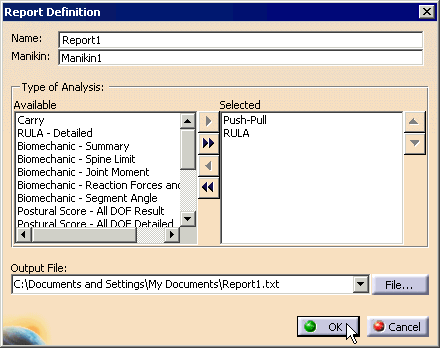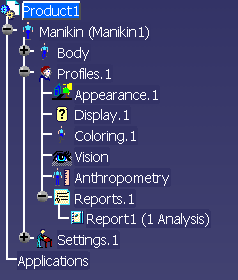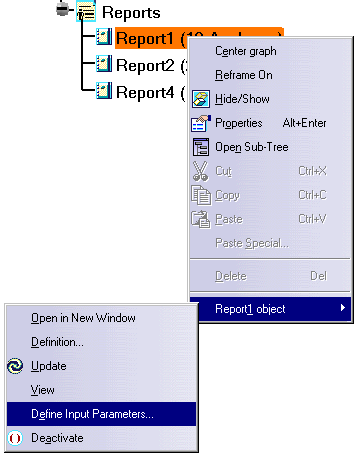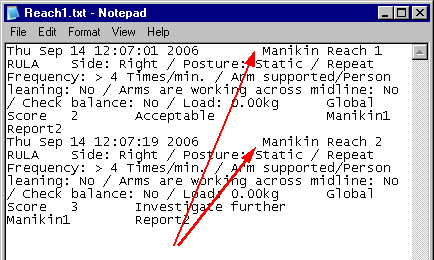-
In the Human Builder workbench select the Inserts
a new Report
 command that is located in the Insert menu bar or in the
Manikin Tools
toolbar.
command that is located in the Insert menu bar or in the
Manikin Tools
toolbar.
-
Selecting the Inserts a new Report command,
you are then prompted to select a manikin the new object will belong
to. Once the manikin is selected, the Report Definition
panel appears:

-
You can choose any combination of analyses to populate
the report, by toggling them from the Available column to
the Selected column. The Output File field contains a
default path, pointing to the V5 temporary directory (CATTemp), but you
can change the output file of the report by clicking the File...
button. This field also contains a history of the last few report
files used (hence the combo). If the output file name's extension
is .htm or .html, then the report written to this
file will be in html format, Otherwise, the report will be written in
text format.
This default path can be changed in the Tools > Options
> Human Builder >
General tab.
Each report object must be associated to a specific log
file; however, it is permitted to assign two or several different
report objects to the same log file.
-
You will be able to choose from the following list of
analyses, on any report object:
- Push/Pull analysis
- Carry analysis
- RULA analysis
- Detailed RULA analysis
- Biomechanics analysis - summary
- Biomechanical - Spine Limit
- Biomechanical - Joint Movement
- Biomechanical - Reaction Forces and Moment
- Biomechanical - Segment Angle
- Postural Score analysis - All DOF Result
- Postural Score analysis - All DOF Detailed
- Detailed Postural Score analysis - DOF1
- Detailed Postural Score analysis - DOF2
- Detailed Postural Score analysis - DOF3
- Constraint Results
- Vision Analysis
- Walk Distance-Single Walk
- Walk Distance - Cumulative
|
-
Any combination of analyses can be activated, and each
report object must point to a valid output file. A specific
analysis in the above list will be selectable for activation only if
the proper product license check succeeds for this analysis. For
instance, the Push/Pull and RULA analyses will be selectable only if
the Human Activity Analysis product is installed.
-
While editing the report properties, clicking another
manikin will switch that report object to the new manikin. The
name of the manikin associated to the report object appears in the
Manikin field. Also, a default name (i.e. Report1 Report 2...) is
given to the report object. Change the name before you select OK.
-
When completed, the new report object appears under the
selected manikin, in the specification tree:

-
Right-clicking on the Reports.1 shows the options
available.

-
The Define
Input Parameters dialog box contains all the explicit parameters for each
analysis, organized in dialog’s tab pages.
-
Descriptions can also be created for the vision, the
anthropometry, or the posture of the manikin using the Adds a
description to a manikin object command. Select the appropriate
node in the specification tree (Manikin, Anthropometry, Vision, or
Body) and the corresponding description will appear in the text field.
-
After configuring the report object for a specific
manikin, the launch of the Update
 command in the Human Builder workbench. This will cause each
active report object to update, and each object will send the results
of the activated analyses into its respective log file. Please
note that the dialog panels of the corresponding analyses do not
need to be open for the report objects to work. That
is, the relevant analyses are performed in the background, using the
manikin's current posture, and no message panel pops up during the
process.
command in the Human Builder workbench. This will cause each
active report object to update, and each object will send the results
of the activated analyses into its respective log file. Please
note that the dialog panels of the corresponding analyses do not
need to be open for the report objects to work. That
is, the relevant analyses are performed in the background, using the
manikin's current posture, and no message panel pops up during the
process.
-
If required to do repetitive positions, you are able to enter a custom label at updating by activating the
Enable custom label at update in the Tools > Options > Ergonomics
> Human Builder> General tab.


Here is a example of a RULA Report.

-
Also note that the Auto Update feature will
not interfere with the log production. That is, even if the
constraint Update mode is set to Automatic (through the
Tools > Options panel of Human Builder),
select Update
 in order to get the log updated.
in order to get the log updated.
-
The Update will therefore have two distinct
functions: update the constraints of each manikin in the current
document (if any), its current function, and then, perform an update
of the log for each manikin of the current document that has at
least one report object activated. Each click on the Update
augments a given log file, without overwriting the previous
information appearing in that file. At any given time, you can
view a log file by other means than V5 (i.e. Notepad, Internet
Explorer, Microsoft Office) to verify its contents. If an
activated analysis points to a target log file that does not exist,
then that log file is created by its report object and populated on
the next Update. If, at
that time, for any reason, the log file, cannot be written into
(because of bad file access permissions for example), then the
appropriate error panel informs you of the situation.
-
The contextual menu of a report object will offer the
following commands:
- Cut
- Copy
- Paste
- Delete
- Activate
- Deactivate
- Update
- Show Log
- Edit
|
-
The Cut, Copy, Paste and Delete commands are
straightforward. The activate/deactivate commands can be used to
activate/deactivate a given report object. Inactive report
objects will NOT produce an entry in their respective log file when the
global Update  is launched.
is launched.
-
The Update command in a report object's contextual menu
can be used to force an active report object to update its log file,
using the manikin's current posture. It is this command which is
actually called upon in the background on every active report object
when the global Update command (from the workbench) is executed.
You can also use the Update command on the contextual menu of the
Reports node, to update all active reports of one manikin in one
operation.
-
The Show Log... command in a report object's
contextual menu will open a read-only window displaying the contents of
the log file associated to that report object. Every time the
global or local Update command is launched, the content of that window
is updated automatically. Please note that the Show Log...
command is available only on active report objects.
The Edit command pops up the Report Properties panel,
just as when double-clicking the object.
For Reporting Capabilities
see:
Lift-Lower analysis
Push-Pull Analysis
Carry Analysis
Log File txt Format
Log File HTML Format
RULA analysis in XML Format
Vision analysis
![]()